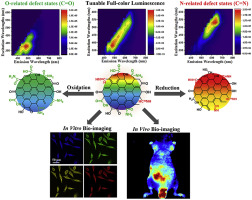Our official English website, www.x-mol.net, welcomes your
feedback! (Note: you will need to create a separate account there.)
Oxygen/nitrogen-related surface states controlled carbon nanodots with tunable full-color luminescence: Mechanism and bio-imaging
Carbon ( IF 10.5 ) Pub Date : 2020-04-01 , DOI: 10.1016/j.carbon.2020.01.029 Lei Wang , Xuehui Zhang , Kun Yang , Luning Wang , Chun-Sing Lee
Carbon ( IF 10.5 ) Pub Date : 2020-04-01 , DOI: 10.1016/j.carbon.2020.01.029 Lei Wang , Xuehui Zhang , Kun Yang , Luning Wang , Chun-Sing Lee

|
Abstract Fluorescent carbon nanodots (CNDs) have exhibited attractive potential for biomedical applications due to their intriguing luminescent properties and good biocompatibility. One interesting properties of CNDs is that they typically show different emission colors upon optical excitation using different wavelengths. However, it is still a challenge to obtain emissions covering the entire visible spectrum with comparable intensity with only one type of CND. Herein, CNDs with tunable full-color luminescence is successful prepared by a solvothermal approach, show broad absorption (200–700 nm) and fluorescence emission (nearly cover the entire visible region: from 400 to 700 nm) with comparable fluorescence intensities. The oxidation (o-CNDs) and reduction (r-CNDs) of CNDs surface would lead to the shifting of photoluminescence band into blue/green and red-light region, respectively. Further spectroscopic analyses and structural characterizations of CNDs (pristine state), o-CNDs (oxidation state) and r-CNDs (reduction state) demonstrate that O-related defect states (C O) and N-related defect states (C N) on surface of CNDs should be responsible for blue/green and red fluorescence emissions, respectively. Moreover, the CNDs are found to be biocompatible, as verified by in vitro cells assay and in vivo histological analysis. In vivo fluorescence imaging assay demonstrates that CNDs can be excreted through intestine and bladder system. The tunable full-color emission, good biocompatibility and metabolism suggest that the CNDs are promising fluorescent probes for biomedical applications.
中文翻译:

氧/氮相关表面状态控制具有可调全色发光的碳纳米点:机制和生物成像
摘要 荧光碳纳米点 (CND) 由于其引人入胜的发光特性和良好的生物相容性而在生物医学应用中展现出极具吸引力的潜力。CND 的一个有趣特性是它们通常在使用不同波长的光激发时显示不同的发射颜色。然而,仅使用一种类型的 CND 获得覆盖整个可见光谱的具有可比强度的发射仍然是一个挑战。在此,通过溶剂热方法成功制备了具有可调全色发光的 CND,显示出广泛的吸收(200-700 nm)和荧光发射(几乎覆盖整个可见区域:400-700 nm),具有可比的荧光强度。CNDs 表面的氧化 (o-CNDs) 和还原 (r-CNDs) 将导致光致发光带分别向蓝/绿和红光区域移动。CNDs(原始态)、o-CNDs(氧化态)和 r-CNDs(还原态)的进一步光谱分析和结构表征表明,表面上的 O 相关缺陷态 (CO) 和 N 相关缺陷态 (CN) CND 应分别负责蓝色/绿色和红色荧光发射。此外,通过体外细胞测定和体内组织学分析证实,CND 具有生物相容性。体内荧光成像分析表明,CNDs 可以通过肠道和膀胱系统排出体外。可调全彩发射,
更新日期:2020-04-01
中文翻译:

氧/氮相关表面状态控制具有可调全色发光的碳纳米点:机制和生物成像
摘要 荧光碳纳米点 (CND) 由于其引人入胜的发光特性和良好的生物相容性而在生物医学应用中展现出极具吸引力的潜力。CND 的一个有趣特性是它们通常在使用不同波长的光激发时显示不同的发射颜色。然而,仅使用一种类型的 CND 获得覆盖整个可见光谱的具有可比强度的发射仍然是一个挑战。在此,通过溶剂热方法成功制备了具有可调全色发光的 CND,显示出广泛的吸收(200-700 nm)和荧光发射(几乎覆盖整个可见区域:400-700 nm),具有可比的荧光强度。CNDs 表面的氧化 (o-CNDs) 和还原 (r-CNDs) 将导致光致发光带分别向蓝/绿和红光区域移动。CNDs(原始态)、o-CNDs(氧化态)和 r-CNDs(还原态)的进一步光谱分析和结构表征表明,表面上的 O 相关缺陷态 (CO) 和 N 相关缺陷态 (CN) CND 应分别负责蓝色/绿色和红色荧光发射。此外,通过体外细胞测定和体内组织学分析证实,CND 具有生物相容性。体内荧光成像分析表明,CNDs 可以通过肠道和膀胱系统排出体外。可调全彩发射,











































 京公网安备 11010802027423号
京公网安备 11010802027423号